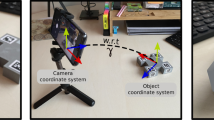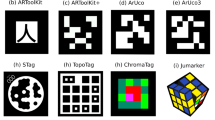Abstract
Fiducial marker based Augmented Reality has many applications. So far the inner pattern of the fiducial marker is always used to encode the markers. Thus a large portion of the fiducial marker image is used for encoding instead of providing corresponding feature points for pose accuracy. This paper presents a novel method which utilizes directly the projective invariant contained in the positional relation of the corresponding feature points to encode the marker. The proposed method does not require the region of pattern image for encoding any more and can provide more corresponding feature points so that higher pose accuracy can be achieved easily. Many related approaches such as cumulative distribution function, reprojection verification and robust process are proposed to overcome the problem of sensibility of the projective invariant. Experimental results show that the proposed fiducial marker system is reliable and robust, and can provide higher pose accuracy than that achieved by existing fiducial marker systems.
Similar content being viewed by others
Explore related subjects
Discover the latest articles, news and stories from top researchers in related subjects.References
Azuma R. A survey in Augmented Reality. Presence — Teleoperations and Virtual Environment, Aug. 1997, 6(4): 355–385.
Ohta Y, Tamura H. Mixed Reality Merging Real and Virtual Worlds. Springer-Verlag, 1999, pp.379–390.
Youngkwan Cho, Jongweon Lee, Ulrich Neumann. A multi-ring fiducial system and an intensity-invariant detection method for scalable augmented reality. In Proc. IEEE and ACM International Workshop on Augmented Reality, San Francisco, California, 1998, pp.147–165.
Leonid N, Eric F. Circular data matrix fiducial system and robust image processing for a wearable vision-inertial self-tracker. In Proc. IEEE International Symposium on Mixed and Augmented Reality (ISMAR’02), Los Alamitos, California, 2002, pp.27–36.
Lopez de Ipina. D. TRIP: A low-cost vision-based location system for ubiquitous computing. Personal and Ubiquitous Computing, May 2002, 6(3): 206–219.
Forsyth, D. Invariant descriptors for 3-d object recognition and pose. IEEE Trans. Pattern Analysis and Machine Intelligence, 1991, 13(10): 971–991.
C B Owen, Fan Xiao, P Middlin. What is the best fiducial? In Proc. 1st IEEE International Workshop on Augmented Reality Toolkit, Darmstadt, Germany, Sept. 2002, p.8.
Kato H, Billinghurst M. Marker tracking and HMD calibration for a video-based Augmentnd Reality conferencing system. In Proc. 2nd IEEE and ACM International Workshop on Augmented Reality (IWAR 99), San Francisco, CA, 1999, pp.85–94.
Zhang X, Fronz S, Navab N. Visual marker detection and decoding in AR systems: A comparative study. In Proc. Int. Symp. Mixed and Augmented Reality, Darmstadt, Germany, 2002, pp.97–106.
Rekimoto J. Matrix: A realtime object identification and registration method for augmented reality. In Proc. 3rd Asia Pacific Computer Human Interaction, Hayama-machi, Kanagawa, Japan, July 15–17, 1998, pp.63–68.
Rekimoto J, Ayatsuka Y. CyberCode: Designing Augmented Reality environments with visual tags. In Proc. Designing Augmented Reality Environments, Denmark, April 2000, pp.1–10.
Zhang X, Navab N. Tracking and pose estimation for computer assisted localization in industrial environments. In Proc. Applications of Computer Vision, 4–6 Dec. 2000, pp.214–221.
Zhang X, Navab N, Liou S. E-commerce direct marketing using augmented reality. In Proc. IEEE Int. Conf. Multimedia Expo., New York, 2000, pp.88–91.
Fiala M. Fiducial marker systems for augmented reality: Comparison between ARTag and ARToolkit. In Proc. MIRAGE 2005: Computer Vision/Computer Graphics Collaboration for Model Based Imaging, Rendering, Image Analysis and Graphical Special Effects, INRIA Rocquencourt, France, Mar. 2005.
Fiala M. ARTag, a fiducial marker system using digital techniques. In Proc. IEEE Computer Vision and Pattern Recognition (CVPR 2005), San Diego, California, June 2005, pp.590–596.
David F, Joseph M, Andrew Z, Chris C, Aaron H, Charles R. Invariant descriptors for 3D object recognition and pose. IEEE Trans. Pattern Analysis and Machine Intelligence, October 1991, 23(2): 116–128.
Vassilios T, Konstantinos C, Panos T. Landmark-based navigation using projective invariants. In Proc. 1998 IEEE/RSJ Int. Conference on Intelligent Robots and Systems, Canada, October 1998, pp.342–347.
George B, Michael G, Niels L. Learning geometric hashing functions for model-based object recognition. IEEE Transactions on Neural Networks, 1998, 9(5):560–570.
Isaac W, Manjit R. Model-based recognition of 3D objects from single images. IEEE Trans. Pattern Analysis and Machine Intelligence, February 2001, 23(2): 116–128.
Robert L, Jurriaan M. Optical tracking using projective invariant marker pattern properties. In Proc. IEEE Virtual Reality 2003 (VR’03), Los Angeles, California, March 2003, pp.191–198.
Alberto S, Antoni L, Walter E. Sensibility, relative error and error probability of projective invariants of planar surfaces of 3d objects. In Proc. 11th IAPR International Conference on Pattern Recognition, Hague, Netherlands, 1992, pp.328–331.
Mundy J, Zisserman A. Geometric Invariance in Computer Vision. Massachusetts: Cambridge, MIT Press, 1992.
Lenz R, Meer P. Point configuration invariants under simultaneous projective and permutation transformations. Pattern Recognition, 1994, 27(11): 1523–1532.
Meer P, Lenz R, Ramakrishna S. Efficient invariant representations. Int. J. Computer Vision, 1998, 26(2): 137–152.
Beucher S, Lantuejoul C. Use of watersheds in contour detection. In Proc. Int. Workshop on Image Processing, Real-Time Edge and Motion Detection/Estimation, Rennes, 1979, pp.17–21.
Gabriella C, Olivier F. Algebraic and geometric tools to compute projective and permutation invariants. IEEE Trans. Pattern Analysis and Machine Intelligence, January 1999, 21(1): 58–65.
Aström K E, Morin L. Random cross ratios. In Proc. Ninth Scandinavian Conf. Image Analyses, 1995, Uppsala, Sweden, pp.1053–1061.
Lu C, Hager G, Mjolsness E. Fast and globally convergent pose estimation from video images. IEEE Trans. Pattern Analysis and Machine Intelligence, 2000, 22(6): 610–622.
OpenCV: Open source computer vision library. http://www.intel.com/research/mrl/research/opencv/.
Author information
Authors and Affiliations
Corresponding author
Additional information
Supported by the National Grand Fundamental Research 973 Program of China (Grant No. 2002CB312104).
Electronic Supplementary Material
Below is the link to the electronic supplementary material.
Rights and permissions
About this article
Cite this article
Li, Y., Wang, YT. & Liu, Y. Fiducial Marker Based on Projective Invariant for Augmented Reality. J. Comput. Sci. Technol. 22, 890–897 (2007). https://doi.org/10.1007/s11390-007-9100-0
Received:
Revised:
Published:
Issue Date:
DOI: https://doi.org/10.1007/s11390-007-9100-0




